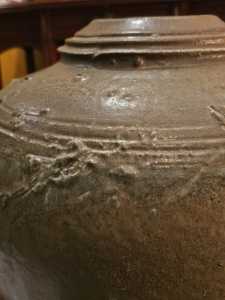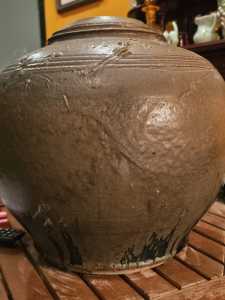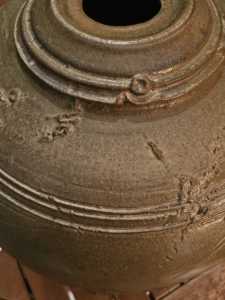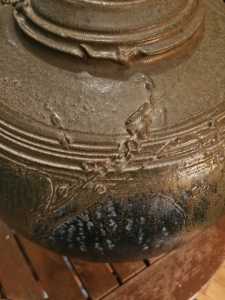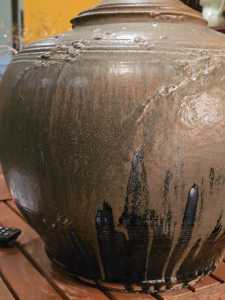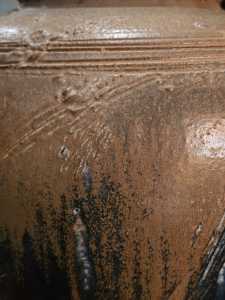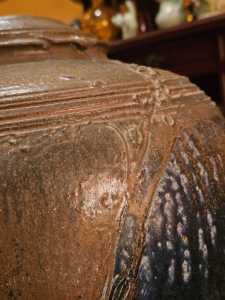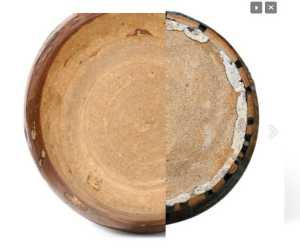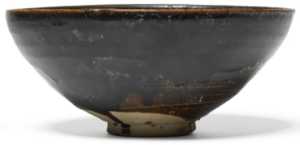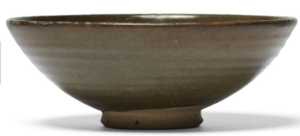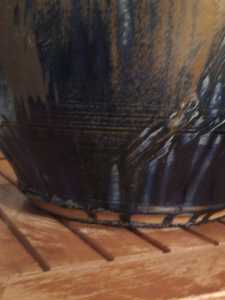The Chinese and Asian Art Forum. For Fans, Collectors and Dealers.
 Basic Rules For the BidAmount Asian Art Forum: Talk about whatever you want. You can even discuss and offer things that are for sale if they are authentic. Maximum image file size per post is 2 MB. Images of 700pxl x 700pxl are optimal if saved at a medium resolution. Be respectful of others and enjoy yourself. Click the YouTube link for a brief tutorial on using the forum. You can also EMBED Videos by cutting and pasting from You-Tube, Vimeo etc.
Basic Rules For the BidAmount Asian Art Forum: Talk about whatever you want. You can even discuss and offer things that are for sale if they are authentic. Maximum image file size per post is 2 MB. Images of 700pxl x 700pxl are optimal if saved at a medium resolution. Be respectful of others and enjoy yourself. Click the YouTube link for a brief tutorial on using the forum. You can also EMBED Videos by cutting and pasting from You-Tube, Vimeo etc.
NOTE: To post an item or add a new post, click open the category title from the FORUM LIST, and CLICK the Blue ADD TOPIC button.
@pbarski93 I'll email you in a bit. Mine is [email protected]
Well im back to square one a bit on this jar.
I reached out to Allison Carter who solely studies Khmer and Cambodian historical culture. Its not actually Khmer...
She asked her colleague and she believes the foot and clay actually match up to China's Guangdong region, maybe by the Shiwan kilns.
Its not every day research gets up ended like this but im gonna have to dig again on this. Going back to earlier info posted, it does add up a bit when comparing both Song/Jin pieces and even Yuan foot techniques.
I may need to reach out to Peter again with more updated info. I see where he would've seen similar before given how the mouth looks, and the shape. Another note is the cobalt may actually be Iron reduction created, and it fits back to the glazes noted earlier about Tenomku style glazing.
Ahh the search continues!
I
That is a shame for you, but I am not surprised it isn't Khmer and I am sure you will enjoy the research.
Did she give you an idea of the period it was made?
@julia Its no worries, I actually welcome having existing research blown out of the water from another expert since it helps refine what we know or may know already. Ill keep digging and figure it out eventually with someone probably soon.
She did not but if we use the information from Peter it sits it around 12th to 14th century still. I followed up asking if she might have an idea of its age too but we'll see if she replies or not.
It would sit it with some earlier guesswork about it being from the maybe the song, Jin or Yuan dynasty if that age is to be believed. The age would make sense as there are other works from this period that match that foot and clay, along with the glaze condition.
Hello All 😊
Interesting piece! Thanks for sharing and documenting the journey, Preston.
Is there any chance all the writing/constellation parts are all part of one (maybe incomplete) dragon in clouds pattern?
I don't think I've ever seen this Jun-like glaze on any old SE Asian pots. Maybe it was the color that tipped @Julia off to Khmer being unlikely? My memory is that Khmer glazes were all iron based, so only browns and greens.
To my eyes the colors are too atypical, and the glazer too thin (as per those streaks), for period Song/Yuan Jun. The clay also looks too grainy and yellow (though that could be photos) for Jun.
Shiwan leaded glazes might be a closer match, for color and consistency, some examples here. Koh also mentions that Vietnam potters had similar Shiwan-Jun glazes from 19th century on.
Let us know what you find!
@craig thanks for your points of interest and no worries on the documentation here!
Regarding the potential cloud and dragon design, I think this is correct. I took a hard look over and reinterpreted the motif designs through Chinese intentions and dragons do seem to fit better once the points are roughly connected over. They trace well once you cross check some points and references to Dragon Jars. Before, these designs were following symbolic patterning around from foot to mouth. The rough form and faded/filled lines makes it difficult to really trace these. The one on the side without the tenmoku style glaze effect is probably the best example, where its head is prominent, the body is long and reaching down to the bottom half of the jar with its tail covered by the tenmoku glaze. The feet are loosely felt or seen. There may be another coming from the sprouting shaft, reaching left, where the tenmoku glaze reaches its highest point on the dominant side. Cloud motifs would make sense too and it almost follows a concept of a Shan Shui in style with the tenmoku glaze acting as rising mountains, maybe something else entirely. Maybe flaming pearls too but it doesn't seem likely with how many are there.
You're right about the glaze effect too, its mainly just unique to China from research around. Generally monochromatic and half glazes would be seen in most regions around from what i have seen through online collections and research papers. Some Thai shapes do relate but not exactly to form or within the clay composition. The collar mouth is the closest to Khmer and Thai as well but its possible this was intentional for export trade. Ultimately though Khmer will generally always be brown or green.
The clay in terms is also pretty close to what I can find from Shiwan area wares too. Its at least in a similar color tone and the clay material is close to a visual match. I'd say its darker near the glaze, a bit lighter in buff down the side to the bottom aside from the kiln furniture stack scars.
After being turned over back to the China origin direction, Jianyao is a really close example of glaze work to consider this towards, but the colors are imbalanced and abstracted plus its not the right region of affiliation. Ie more green than browns, and less direct intentional pattern and more story telling.
https://www.christies.com/en/lot/lot-6018818
It would be interesting as a one of a kind in concept so far since so little evidence exists of another even by direct glaze considerations. So far, an anomaly but I hope to consult the right specialists next to determine it further.
I may have found a more definiative link and it may actually be Jizhou/Fujian.
When comparing the bottom jar of a pair of jizhou tortoishell glazed vases it does appear that there are clear resemblances in the clay and setting. Side by side combination of the right vase do show a pretty good comparison of similarities of the clay and setting.
When comparing to a pair of Jizhou green and brown glazed tea bowls, a few ticks line up with the green to the jar, the angled foot outward and then inward on both the jar and the bowls, even the vases.
If we imagine the glaze being pulled back up further, the same angled foot approach does appear in the jar's form.
It seems more plausable in this direction. It also makes sense for the region too. Some coloring may be different here and there but characteristically, it begins to line up.
Thoughts?
Thanks for visiting "The BidAmount Asian Art Forum | Chinese Art"
If you sell on eBay, or have a shop feel free to post images and descriptions and links.
Check back often for discussion about the latest news in the Chinese art and antique world. Also find out about the latest Asian art auctions at Sotheby's, Christie's, Bonhams and Tajans.
Auction results for: fine porcelain, ceramics, bronze, jade, textiles and scholar's objects. As well as Japanese, Thai, Vietnamese and other Asian cultures.
Thank you,
Peter Combs
Topics and categories on The BidAmount Asian Art Forum | Chinese Art
Kangxi vases, Kangxi dishes and chargers, Kangxi ritual pieces, Kangxi scholar's objects, Qianlong famille rose, Qianlong enamels, Qianlong period paintings, Qianlong Emporer's court, Fine porcelain of the Yongzheng period. Chinese imperial art, Ming porcelain including Jiajing, Wanli, Xuande, Chenghua as well as Ming jades and bronzes.
The BidAmount Asian Art Forum | Chinese Art
A free Asian art discussion board and Asian art message board for dealers and collectors of art and antiques from China, Japan, Korea, Thailand, Cambodia, Vietnam and the rest of Asia. Linked to all of the BidAmount Asian art reference areas, with videos from plcombs Asian Art and Bidamount on YouTube. Sign up also for the weekly BidAmount newsletter and catalogs of active eBay listing of Chinese porcelain, bronze, jades, robes, and paintings.
The art of calligraphy - and for the ancient Chinese it certainly was an art - aimed to demonstrate superior control and skill using brush and ink. Calligraphy established itself as one of the major Chinese art forms during the Han dynasty (206 BCE - 220 CE), and for two millennia after, all educated men were expected to be proficient at it.
The Museum’s collections of Asian art span nearly five millennia and encompass the cultures of China, the Himalayas, India, Japan, Korea, and Southeast Asia. In 2007, the Museum launched an initiative to create dedicated galleries for the collection, beginning with a gallery for the arts of Korea ...
Chinese art is full of symbolism, in that artists typically seek to depict some aspect of a totality of which they are intuitively aware.
China Online Museum is the finest online museum of Chinese art. It features Chinese calligraphy, painting, ceramics, bronzes, carving, and other artworks.
Chinese Ceramics & Works of Art. Overview Upcoming auctions Contacts Auction results ... Christie’s sales of Chinese ceramics and works of art showcase centuries of Chinese history. Held throughout the year in London, New York, Paris and Hong Kong, they attract a wide audience of collectors and connoisseurs vying for pieces as diverse as ...
Explore Asian Art Week. Contact the Specialist Department. Chinese Paintings ... Senior Specialist, Head of Sale. [email protected]. Tel:+1 212 641 5760. Bid in-person or online for the upcoming auction:Fine Chinese Paintings on 10 September 2019 at New York. Bid in-person or online for the upcoming auction:Fine Chinese Paintings on 10 ...
Discover an abundance of must-see art from all corners of a vast continent at Christie’s NY Asian Art Week. From contemporary classical and Chinese paintings to works with exemplary provenance from the Art Institute of Chicago, our Rockefeller Paza galleries will be full of ancient treasures and contemporary masterworks in a salute to the vibrant arts of Asia.
Sold to benefit The Art Institute of Chicago’s Asian Art Acquisition Fund, the sale features 84 lots with a focus on Ming and Qing porcelains, and offers a rare insight into the taste for collecting Chinese ceramics and works of art in the Midwest from the end of the 19th century through the 1980s. Highlights include two Wanli wucai garlic-head vases, a Qianlong mark and period, blue and ...
Specialist, Chinese Paintings, Christie's London Dr Malcolm McNeill is a Specialist in Chinese Paintings at Christie’s, based in London. He previously worked as an assistant curator of the Chinese collections and the Victoria and Albert Museum in London, as a researcher at the British Museum, and as a translator and tour guide at the National Palace Museum in Taipei.
The Christie's Education 2020 Conference: The Chinese Art Market 18 Jun 2019 Christie’s Education is delighted to announce our first international academic conference in Asia which will take place in Hong Kong from 26-27 November 2020 at the Hong Kong Convention and Exhibition Centre and will run in parallel with Christie’s Hong Kong Autumn Auctions.
The summer Chinese Art sale in Hong Kong will feature works of art from several private collections, including Qing porcelains and textile from the collection of the legendary Chinese art dealer A. W. Bahr (1877–1959), fine gilt bronze Buddhist sculptures from an old Hong Kong collection, an East Asian collection of Qing dynasty wine cups and jades, and a Japanese collection of Song ceramics ...
Sotheby's Chinese Works of Art Department holds two auctions each year in London, New York, Hong Kong and Paris.
Chinese Art - View Auction details, bid, buy and collect the various artworks at Sothebys Art Auction House.
With more than 340 Chinese works of art dating from the Neolithic to the Republic periods, highlights of this sale include a selection of Qing Imperial monochromes from the collection of Arnold and Blema Steinberg, early ceramics from the Art Institute of Chicago and Chinese porcelain and works of art from the collection of Henry Arnhold.
Results: Sotheby's Asia Week achieved $52.4 million in six strong auctions, exceeding pre-sale estimates. With 76.5% of lots sold and 60.3% of lots surpassing high estimates, the Asian art sales at Sotheby's indicate continued collector interest in the finest works of art from China, India and and the Himalayas.
Today's sale of Important Chinese Art will proceed as planned with sessions at 10 AM and 2 PM EDT. Sotheby's will be monitoring the weather conditions throughout the day and will be available to coordinate alternative bidding options should conditions make it difficult for clients to attend the auction in person.
Bonhams Chinese Art department is renowned for offering the finest works of art representing the richness and breadth of China's artistic heritage, particularly Imperial porcelain, white and spinach green jades, cloisonné and Buddhist art. Specialised international auctions are held globally, including London, Hong Kong and San Francisco.
Bonhams : Chinese Works of Art We use cookies to remember choices you make on functionality and personal features to enhance your experience to our site. By continuing to use our site you consent to the use of cookies. Please refer to our privacy and cookie policies for more information.
Bonhams Fine Art Auctioneers & Valuers: auctioneers of art, pictures, collectables and motor cars. We use cookies to remember choices you make on functionality and personal features to enhance your experience to our site. By continuing to use our site you consent to the use of cookies. ... Chinese Art (US) General enquiries
Bonhams : Fine Chinese Art We use cookies to remember choices you make on functionality and personal features to enhance your experience to our site. By continuing to use our site you consent to the use of cookies. Please refer to our privacy and cookie policies for more information.
Bonhams Fine Art Auctioneers & Valuers: auctioneers of art, pictures, collectables and motor cars Bonhams : Asian Art We use cookies to remember choices you make on functionality and personal features to enhance your experience to our site.
Bonhams are international auctioneers of fine Chinese and Japanese art. We specialise in rare Imperial and Export Chinese ceramics and works of art, as well as Japanese ceramics, fine and decorative works of art from the Neolithic Period to the 20th century. View on map
Bonhams Fine Art Auctioneers & Valuers: auctioneers of art, pictures, collectables and motor cars. We use cookies to remember choices you make on functionality and personal features to enhance your experience to our site. By continuing to use our site you consent to the use of cookies. ... Asian Art Bonhams. Work. 22 Queen St.

